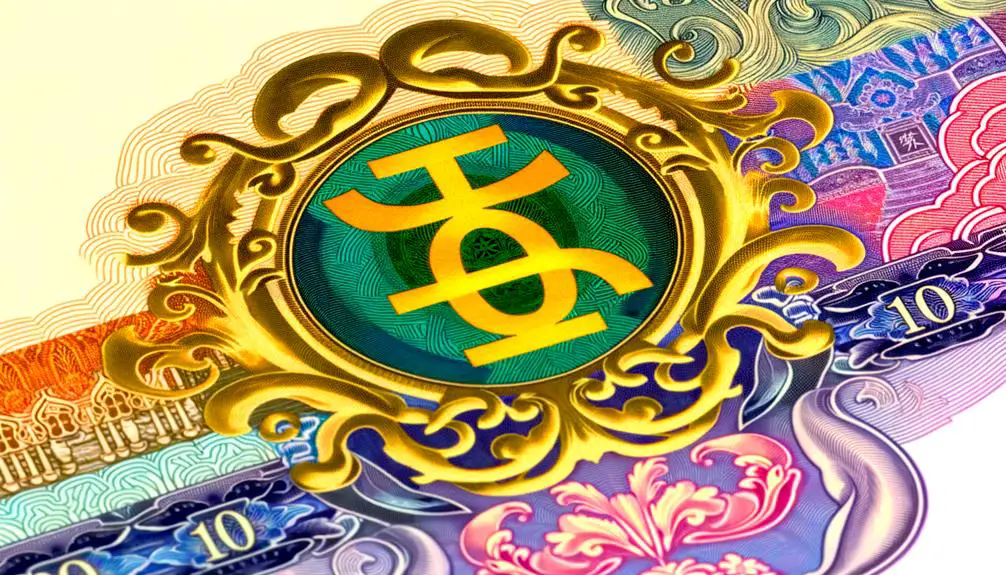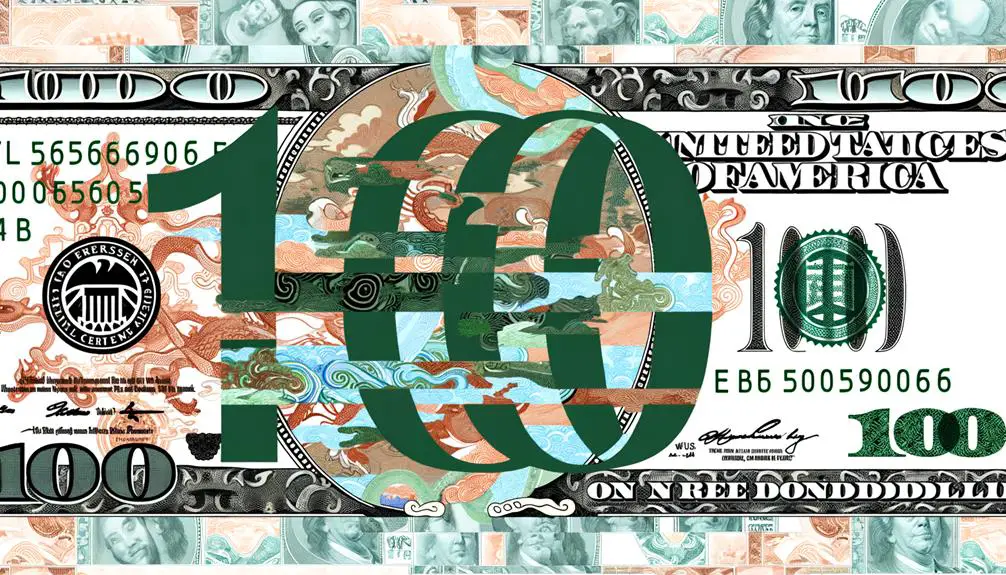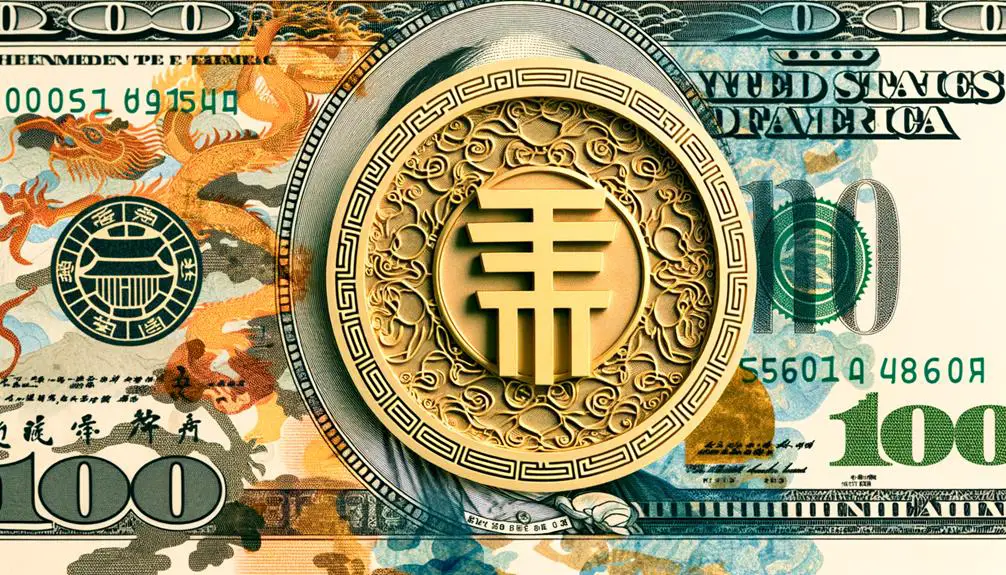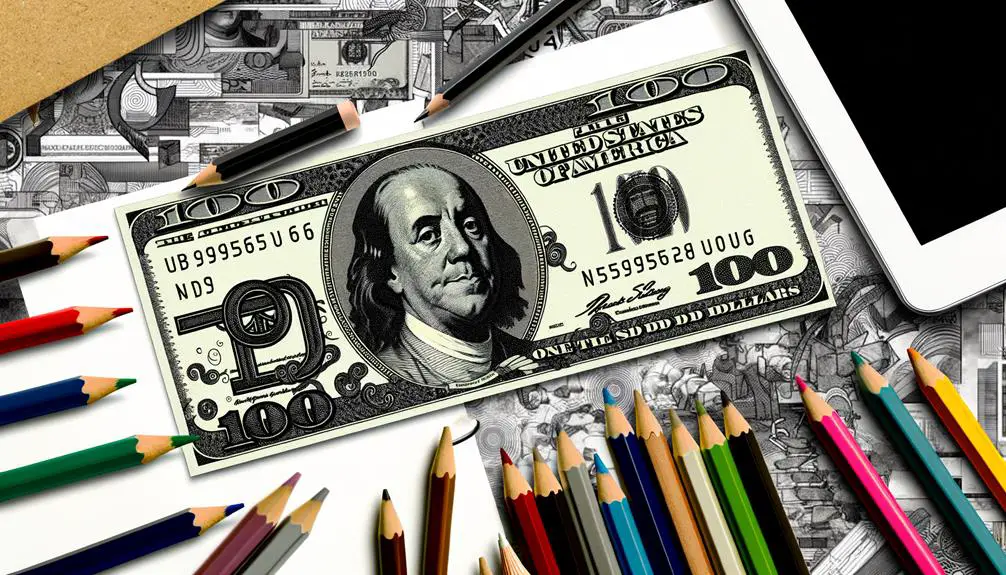How to Identify Chinese Symbols on a 100 Dollar Bill
The Chinese symbol on the 100 dollar bill reflects significant historical and cultural ties between the United States and China. It underscores the long-standing trade relationships and contributions by Chinese immigrants during the China Trade era.
The design, influenced by ancient Chinese traditions and calligraphy, symbolizes the integration of Eastern and Western heritage. Its inclusion on the currency denotes appreciation for these cultural exchanges and highlights China's pivotal role in global economics.
This blend of cultural significance and historical context enriches the bill's narrative, emphasizing the depth of these bilateral connections. Explore further to uncover the intricate layers behind this symbol.

Key Takeaways
- The Chinese symbol on the 100 dollar bill underscores historical trade relations and cultural exchanges between the US and China.
- It highlights the intertwined histories and economic interactions between Eastern and Western civilizations.
- The symbol's design reflects meticulous integration and embodies values from ancient Chinese calligraphy.
- The inclusion signifies the integration of Chinese cultural elements into American symbols, emphasizing global interactions.
- Public reactions reflect a mix of appreciation and concern, recognizing the impact of globalization on national identity.
Historical Background

The incorporation of Chinese symbols on the 100 dollar bill can be traced back to a complex interplay of historical trade relations and cultural exchanges between the United States and China.
These two nations, despite their geographical distance, have interacted significantly since the 19th century, particularly during the era of the China Trade. American merchants were keen to establish lucrative trade ties, importing tea, silk, and porcelain from China while exporting cotton and tobacco.
This period also saw the influx of Chinese immigrants, contributing to cultural intermingling. Such exchanges left an indelible mark on American society, including its currency.
The presence of Chinese symbols on U.S. currency underscores the depth of these historical connections and highlights the nuanced layers of cultural appreciation and mutual influence.
Design Elements
Building on this historical background, the design elements of the 100 dollar bill reflect a confluence of artistic and cultural influences, prominently featuring Chinese symbols that are meticulously integrated into the currency's aesthetic.
The incorporation of these symbols is not merely decorative but serves as a reflection of the deep historical ties and shared heritage between Eastern and Western civilizations. This integration extends beyond mere ornamentation, revealing layers of cultural significance and historical context.
The choice of symbols and their placement on the bill underscore an appreciation for Chinese artistry and its historical relevance. These design elements thereby provide a rich tapestry that bridges diverse cultural narratives, enhancing both the visual appeal and the symbolic depth of the currency.
Symbol Description
The Chinese symbol on the 100 dollar bill carries profound historical significance, reflecting centuries of cultural exchange and influence. Its inclusion is not merely decorative but serves as a nod to the intertwined histories and economic relations between the United States and China.
Understanding this symbol through the lens of cultural interpretation reveals deeper insights into its role in promoting global interconnectedness and mutual respect.
Historical Significance
Often overlooked, the Chinese symbol on the 100 dollar bill encapsulates a rich tapestry of historical and cultural significance, tracing back to ancient Chinese traditions. The symbol, embedded within the design, evokes the profound influence of Chinese calligraphy which dates back to the Shang Dynasty (1600-1046 BCE).
Historically, such symbols were not merely decorative but served as conduits for conveying philosophical and moral principles intrinsic to Confucianism and Daoism. The integration of this symbol on a modern currency like the 100 dollar bill underscores a recognition and homage to the enduring legacy of Chinese culture.
It reflects a historical acknowledgment of the cross-cultural exchanges that have enriched global art, philosophy, and commerce throughout centuries.
Cultural Interpretation
Embedded within the intricate design of the 100 dollar bill, the Chinese symbol serves as a cultural artifact that encapsulates centuries of philosophical and artistic tradition. This symbol, often representing concepts like prosperity or harmony, is deeply rooted in Chinese history and thought.
Its presence on the bill transcends mere decoration, highlighting a bridge between Eastern and Western cultures. Historically, Chinese symbols have been revered for their aesthetic and spiritual value, embodying principles found in Confucianism, Taoism, and Buddhism.
Origin of the Symbol
The origin of the Chinese symbol on the 100 Dollar Bill can be traced back to historical interactions between the United States and China, reflecting a period of burgeoning economic and cultural exchanges.
This symbol holds significant cultural meaning, embodying values and traditions that resonate within Chinese history.
Over time, the design has evolved to encapsulate the growing influence of Chinese-American relations on global economic landscapes.
Historical Context and Meaning
To fully comprehend the historical context and meaning of the Chinese symbol on the 100 dollar bill, one must explore its origins and the cultural significance it holds.
The symbol, often mistaken for a modern addition, has roots in ancient Chinese calligraphy. Historically, such symbols were used in imperial edicts and scholarly texts, embodying values of wisdom and prosperity.
The incorporation of this symbol onto currency serves as a bridge between East and West, reflecting global interactions and mutual respect. Its presence on the 100 dollar bill underscores the complex interweaving of historical narratives and cultural exchanges, emphasizing the importance of understanding diverse heritage in a globally connected economy.
Cultural Significance Explored
Understanding the origin of the Chinese symbol on the 100 dollar bill requires delving into its deep-seated cultural significance and historical roots in ancient Chinese traditions. The symbol, often found in Chinese calligraphy, embodies principles that have shaped Chinese society for millennia. It reflects the philosophical underpinnings of Confucianism and Daoism, emphasizing harmony, balance, and prosperity.
| Aspect | Significance |
|---|---|
| Historical Roots | Traced back to ancient Chinese dynasties |
| Philosophical Influence | Reflects Confucian and Daoist ideals |
| Cultural Symbolism | Represents harmony, balance, and prosperity |
| Artistic Expression | Integral part of Chinese calligraphy and art |
| Modern Interpretation | Seen as a bridge between Eastern and Western cultures |
This profound cultural symbol encapsulates a wealth of wisdom, connecting the past with contemporary global interactions.
Design Evolution Over Time
Tracing the design evolution of the Chinese symbol on the 100 dollar bill reveals its intricate journey from ancient calligraphy to modern currency aesthetics.
Historically, Chinese characters have been revered not only for their linguistic importance but also for their artistic value. Originating from traditional brush strokes, these symbols embody centuries of cultural heritage.
Over time, as global financial systems evolved, the integration of such symbols in currency design has underscored the interconnectedness of diverse cultures. The inclusion of a Chinese symbol on the 100 dollar bill signifies respect for this rich history while acknowledging China's pivotal role in the global economy.
This synthesis of ancient artistry and contemporary design epitomizes a bridge between historical reverence and modern economic realities.
Cultural Significance

The inclusion of a Chinese symbol on the 100 dollar bill highlights the intricate ways in which cultural symbols intersect with global financial instruments, reflecting deep historical and economic connections.
This addition serves as a nod to the significant influence of Chinese culture and economy on the global stage. Historically, China has been a pivotal player in international trade, dating back to the Silk Road.
The presence of this symbol underscores the importance of acknowledging cultural heritage within modern financial systems. Moreover, it represents a bridge between East and West, fostering mutual respect and understanding.
The symbol's integration on such a prominent currency exemplifies how cultural and economic histories are woven together, resonating with a global audience attuned to these dynamics.
Symbol's Journey
Exploring the historical trajectory of the Chinese symbol's inclusion on the 100 dollar bill reveals a fascinating interplay of cultural exchange and economic evolution. This symbol's journey can be traced back to pivotal moments in history where economic ties between the United States and China were strengthened, reflecting mutual respect and acknowledgment.
| Year | Event |
|---|---|
| 1972 | Nixon's visit to China |
| 1985 | Sino-US trade agreement |
| 2008 | Financial crisis and global economic shift |
| 2020 | Increasing Chinese investments in the US |
Each period marks a significant milestone, showcasing the gradual but impactful integration of Chinese cultural elements into American symbols of economic power. This inclusion not only highlights the importance of Sino-American relations but also underscores the broader theme of globalization.
Involvement of Designers

Although the inclusion of the Chinese symbol on the 100 dollar bill may seem like a straightforward decision, it was the result of a meticulous design process involving extensive collaboration between cultural historians, economists, and graphic designers.
This interdisciplinary team aimed to confirm the symbol's accuracy, contextual relevance, and aesthetic integration. Cultural historians provided insights into the symbol's historical and cultural resonance, validating it was correctly represented. Economists evaluated the potential impact on international perceptions of the U.S. dollar, while graphic designers worked to seamlessly incorporate the symbol into the existing design framework.
This collaborative effort highlighted the importance of cultural sensitivity and historical awareness in modern currency design, ultimately enriching the bill's narrative and significance.
Currency Evolution
The evolution of currency reflects both technological advancements and shifts in cultural values. Historical changes and modern design updates demonstrate this dynamic. Specifically, the incorporation of symbols from various cultures, such as the Chinese character on the 100-dollar bill, signifies a broader acknowledgment of global influences.
This progression underscores a dynamic interplay between tradition and innovation in the world of monetary design.
Historical Currency Changes
As global economies evolved, the transformation of currency, including the integration of various symbols, reflects complex historical, cultural, and economic shifts.
Historical currency changes have often mirrored the prevailing geopolitical landscapes and cultural exchanges. For instance, the introduction of new symbols on banknotes often signifies the influence of foreign trade and diplomatic relations.
During the 19th and early 20th centuries, Western currencies began incorporating design elements from Eastern cultures, acknowledging the burgeoning economic interactions. Such integrations are not merely decorative; they symbolize mutual respect and recognition of economic interdependence.
The presence of a Chinese symbol on a 100-dollar bill exemplifies these historical currents, highlighting the intricate web of global economic history and cultural amalgamation that continues to shape modern currencies.
Modern Design Updates
In contemporary times, the evolution of currency design is a reflection of advanced security measures, technological advancements, and the embodiment of national identity.
The modern $100 bill, for instance, incorporates cutting-edge features like color-shifting ink, 3D security ribbons, and micro-printing to combat counterfeiting. Historically, these updates mark a significant shift from earlier, more simplistic designs, underscoring the increasing sophistication required to maintain currency integrity.
Culturally, these design elements also serve as symbols of innovation and resilience, reinforcing trust and confidence in the national economy. The inclusion of specific symbols, like the Chinese character for longevity, not only enhances aesthetic appeal but also acknowledges the multicultural dimensions of modern American society, creating a richer narrative in currency design.
Public Reactions

Public reactions to the inclusion of a Chinese symbol on the 100 dollar bill have ranged from expressions of curiosity and appreciation for cultural diversity to concerns about national identity and economic implications. Historically, currency design has often mirrored a nation's cultural and political ethos.
The introduction of a Chinese symbol, as a result, is seen by some as a progressive move reflecting global interconnectedness. Culturally, it signifies recognition of the significant Chinese-American contributions and broader international influence. However, critics argue it may undermine traditional American iconography and raise questions about sovereignty in economic policy.
This blend of admiration and apprehension underscores the complex interplay between embracing globalization and preserving national identity in a rapidly evolving world economy.
Comparisons With Other Bills
Analyzing the inclusion of a Chinese symbol on the 100 dollar bill necessitates a comparison with the iconography of other national currencies to understand the broader cultural and historical implications.
Various countries, such as Japan with its yen and India with its rupee, incorporate national symbols that reflect their rich historical narratives and cultural identities. These emblems often serve as a source of national pride and unity.
The Chinese symbol on the U.S. 100 dollar bill can be viewed through a similar lens, potentially indicating a form of cultural interconnectivity or influence. By comparing these currencies, we recognize that the integration of such symbols is not merely ornamental but deeply rooted in the socio-economic and political fabric of the nations they represent.
Expert Opinions

Scholars and currency experts have weighed in on the implications of incorporating a Chinese symbol on the U.S. 100 dollar bill, offering diverse perspectives that illuminate its cultural, historical, and economic significance. Some analysts argue that this move acknowledges the growing influence of China in global economics. Others highlight historical precedents where currency design reflects geopolitical shifts.
- Cultural Exchange: Some view it as a symbol of cultural respect and exchange.
- Economic Ties: It may underscore the intertwined economic relations between the U.S. and China.
- Historical Precedents: Historical examples of currency reflecting political alliances and rivalries.
- Globalization: Acknowledges the reality of an interconnected global economy.
These insights underscore the multifaceted implications of such a design choice.
Collectors' Insights
Collectors' perspectives on the inclusion of a Chinese symbol on the U.S. 100 dollar bill provide a unique lens through which the historical and cultural significance of this design choice can be examined. Collectors often view such features as emblematic of cross-cultural exchanges and the broader global influence on American currency design. The historical context of incorporating foreign symbols can indicate periods of economic or diplomatic significance. Additionally, the cultural implications of these symbols highlight a recognition and respect for the contributions of different civilizations.
| Perspective | Historical Context | Cultural Significance |
|---|---|---|
| Collectors' View | Reflects cross-cultural exchange | Recognition of global influence |
| Design Rationale | Indicates diplomatic/economic relationships | Honors contributions of various cultures |
| Historical Period | Specific eras of economic/diplomatic shifts | Enhances multicultural appreciation |
| Cultural Impact | Enhances monetary art and design | Promotes global interconnectedness |
Conclusion
In the grand tapestry of global currencies, the inclusion of a Chinese symbol on the 100-dollar bill intertwines historical context with cultural significance, evoking a sense of unity amidst diversity.
This emblem serves as a bridge, connecting disparate cultures through a shared symbol of value and trust.
Public reactions and expert opinions underscore its importance, as this symbol not only decorates but also narrates a broader story of economic and cultural interdependence.






